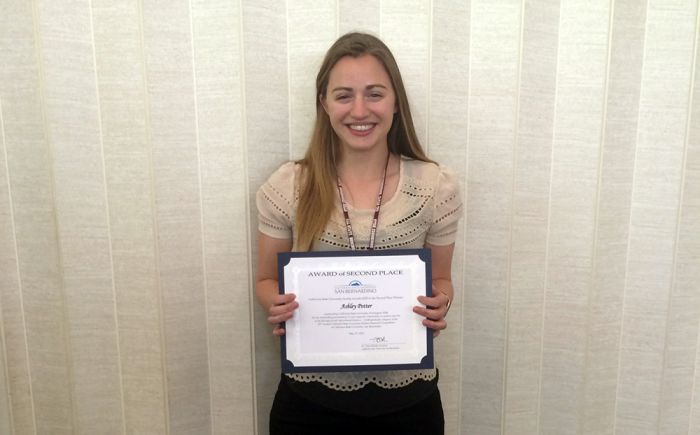 California State University, Dominguez Hills (CSUDH) biology major Ashley Potter took home second place at the CSU Student Research Competition that occurred May 1 and 2 at CSU San Bernardino.
California State University, Dominguez Hills (CSUDH) biology major Ashley Potter took home second place at the CSU Student Research Competition that occurred May 1 and 2 at CSU San Bernardino.
The Long Beach resident won for her presentation on “Bleaching and its Effect on the Competitive Interactions of the Symbiotic Cnidarian, Anthopleura elegantissima,” which garnered her first place at the CSUDH Student Research Day earlier in the year and advanced her to the statewide competition.
“There were so many talented students who worked so hard on their research and presentations,” said Potter of her win. “I felt grateful that my hard work and research efforts had been acknowledged and rewarded.”
Under the mentorship of assistant professor of biology and marine organism expert Jacqueline Padilla-Gamino, Potter wanted to investigate something with a global importance to marine life, and chose to narrow that focus to sea anemones.
“For one, I absolutely love Cnidarians (sea jellies, corals, sea anemones). They are so complex and interesting,” said Potter, who first became interested in biology while a student at Scottsdale Community College in Arizona. She transferred to CSUDH in 2011 and plans to pursue graduate studies in the marine sciences after graduation in fall 2015.
“I decided to research how bleaching, from climate change, affects them,” she continued. “I studied competition because in the ocean an organism’s ability to compete is vital for its survival. The hope is that this would give me a small piece of information that would someday contribute to the bigger picture.”
In her research, Potter explored how physiological stress due to high temperatures can impair the ability of sea anemones (scientific name Anthopleura elegantissima) to compete. According to Potter and Padilla-Gamino, when anemones are stressed they can lose their symbionts (microalgae living inside their cells that can provide nutrients) and this causes them to “bleach.” Bleaching due to global warming has increased in the last decades and several species of anemones and corals have been affected worldwide.
At the CSUDH Student Research Day and CSU Student Research Competition, Potter presented her observations from studying bleached and healthy anemones side-by-side to see if there was a difference in the way they compete for space. Her results showed that unbleached specimens tended to be better competitors than bleached specimens. In her conclusion she argued that if bleached A. elegantissima cannot compete for resources, such as space or food, then their growth and reproduction could be compromised and could affect population dynamics with important consequences for the entire intertidal community.
Potter said the preparation she received from participating in the campus research day really eased her nerves going into the statewide competition.
“The SRD judges asked me questions that really made me think about my research and how to answer questions from judges at the competition,” she said. “SRD also taught me how to recover from mishaps that might occur in my presentation (if videos do not play, etc).”
Beyond sharing her research and winning, Potter enjoyed getting to know different faculty members and students from other majors whom she said she wouldn’t have met otherwise.
“The faculty helped get me ready to compete, and I felt so prepared because of their efforts,” she said. “I also got to connect with other students from CSUDH doing all different types of research. All of those students were absolutely brilliant and I felt honored to attend this competition with so many talented individuals.”

Potter was one of 12 students who competed in the statewide competition after winning at CSUDH Student Research Day in February:
Computer Science
Basil Alhakami, “Integrating Data Aggregation and Data Distribution in Sensor Networks”
Faculty Mentor: Bin Tang
Health Sciences
Whitney Baird, Bethany Grigsby, and Eric Carlson, Occupational Therapy, “Transgender Identity and the Experience of Transition: A Phenomenological Study”
Faculty Mentor: Claudia Peyton, Occupational Therapy
Behavioral and Social Sciences
Shalana Bradford, “Instagram: Seeking Self-Acceptance through Selfies”
Faculty Mentor: Nancy Cheever, Communications
Aimee Miller and Kaitlin O’Brien, Psychology, “The Relationship between Technology Use and the Development of Internet Addiction: Evidence for the Moderating Effect of Executive Function”
Faculty Mentors: Mark Carrier and Larry Rosen, Psychology
Creative Arts
Gabriela Granados, Art and Design, “Chicano Murals: Educational Conduits for Future Generations”
Faculty Mentor: Marisela Chavez, Chicana/Chicano Studies
Biological and Agricultural Sciences
Thalia Jimenez, Biology, “The Role of BMP4/SMAD/Dusp9 Signaling in the Self Renewal of Mammary Cancer Stem Cells”
Faculty Mentor: Leonardo Martinez, Chemistry
Education
Melissa Merrill, Special Education, “What Do You Want? Using Picture Communication Symbols with Bilingual Preschool Aged Children with Special Needs”
Faculty Mentor: Anthony Normore, Special Education
Physical and Mathematical Sciences
Warren Nanney, Chemistry, “Optimization of Small-Molecule F6: Fullerene Organic Solar Cells”
Faculty Mentor: Kenneth Rodriguez, Chemistry
Humanities and Letters
Melissa Williams, English, “Marie De France and Her Subversive Faerie”
Faculty Mentor: Debra Best, English